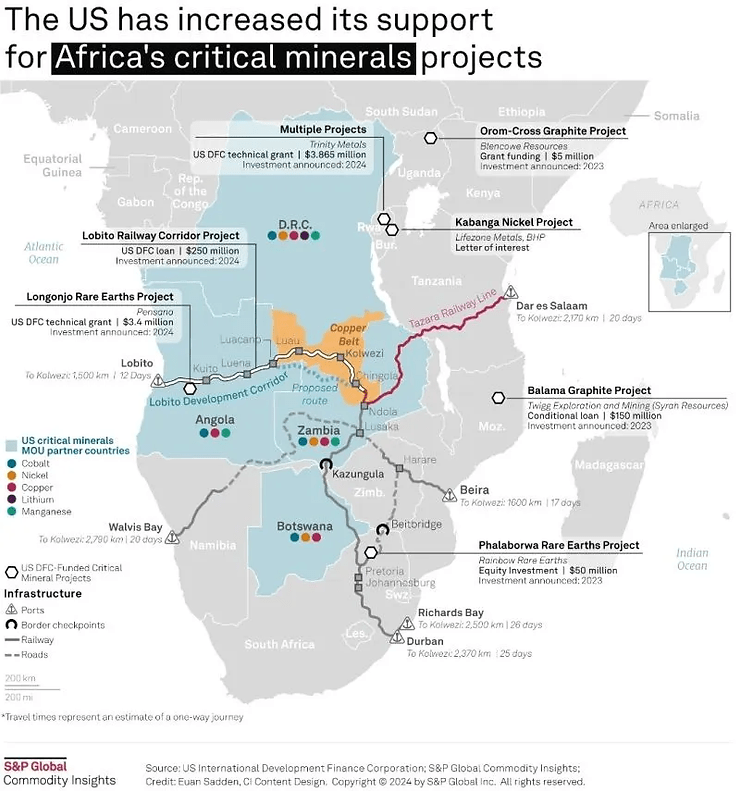In Africa’s quest for sustainable growth and global integration, the Lobito Corridor –connecting Angola, the Democratic Republic of Congo, and Zambia to global markets — emerges as a transformative project—but not for the reasons often highlighted. While infrastructure is critical, its true power lies in how it can reshape economic ecosystems, foster entrepreneurship, and connect people in ways that transcend trade. At Mitrelli, we see the Lobito Corridor as a symbol of what development in Africa should represent: the fusion of infrastructure and social integration.
Rethinking Infrastructure: The Foundation of Growth
Traditionally, infrastructure projects in Africa have mostly been viewed through a utilitarian lens—ports, railways, and roads designed primarily to extract resources and facilitate trade. While these objectives remain vital, they represent only part of the potential. Infrastructure must evolve into something more: a catalyst for holistic and sustainable development.
For the Lobito Corridor, this means building more than transportation networks. It means creating hubs where people and communities are empowered to integrate fully into the economic cycle. Schools, employment, healthcare facilities, access to clean water, and energy solutions are not add-ons—they are the infrastructure. They enable rural communities to evolve into economic contributors and urban centers to grow sustainably. This foundational layer transforms infrastructure into empowerment.
The Human Layer: Social Integration
However, infrastructure alone doesn’t drive change—people do. The Lobito Corridor can only reach its full potential when it bridges more than geographical divides; it must connect individuals to opportunity.
We envision the corridor as a conduit for inclusion. By integrating 40 million people into financial systems, we open doors to economic participation for those who have traditionally been left out. Imagine a farmer in rural Angola, now able to access credit to scale their production and expand global reach. Or a small logistics company in Zambia finding new markets through an efficient railway network. The goal is not simply to move goods but to move people toward prosperity.
This approach creates ripple effects:
- Entrepreneurship Flourishes: When individuals are connected to resources and markets, they innovate.
- Communities Stabilize: Jobs provide not just income but also a stake in the region’s success.
- Regional Economies Strengthen: The corridor doesn’t just facilitate trade; it fosters new industries.
A Gateway to Global Integration
The Lobito Corridor’s promise lies in its potential to be more than a regional asset—it can be a global gateway. By aligning local economies with international markets, it establishes Africa as an indispensable partner in global trade. Yet the success of this vision requires a shift in perspective: from seeing Africa as a source of raw materials to recognizing it as a hub of innovation, growth, and opportunity.
This transformation is not theoretical; it is actionable. Through our two-layer approach—building robust infrastructure and integrating people into economic systems—Mitrelli has demonstrated for over a decade how such projects can evolve from functional to transformational.
The Bigger Picture: Redefining Development in Africa
The Lobito Corridor serves as a microcosm of what development in Africa should aspire to be. It challenges outdated narratives that frame the continent as a beneficiary of aid rather than a driver of global progress. It demands that stakeholders—governments, private sectors, and development agencies—collaborate to build.
I believe that the Lobito Corridor offers a glimpse into Africa’s future: interconnected, inclusive, and globally integrated. But this requires bold leadership, innovative thinking, and a commitment to doing development differently.
It’s time to move beyond the status quo. The Lobito Corridor is not just a railway—it is a blueprint for transformation. We are proud to contribute to this vision, ensuring that the growth it enables is as inclusive as it is sustainable.
